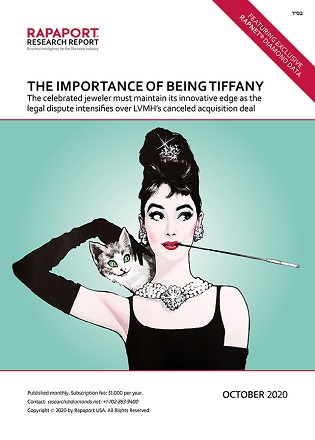|
|
The Importance of Being Tiffany
Insights
Oct 12, 2020 10:24 AM
By Avi Krawitz
|
|
|
RAPAPORT... There was a moment during the 2019 Academy Awards ceremony that made the jewelry world stop and gasp. Lady Gaga, who would later that evening collect the coveted Oscar for best original song, stepped onto the red carpet in an Alexander McQueen dress, black leather gloves, and a storied yellow-diamond necklace by Tiffany & Co. 
The necklace’s 128-carat center stone, which company founder Charles Lewis Tiffany first discovered in South Africa over 140 years ago, hadn’t appeared in public since Audrey Hepburn wore it during the Breakfast at Tiffany’s press tour in 1961. Its sudden appearance at the Oscars, adorning one of music’s most prominent personalities, capped the re-emergence of a brand that had spent the previous two years consciously trying to regain its mojo.
Under CEO Alessandro Bogliolo and artistic director Reed Krakoff, Tiffany transformed into an edgier, more youthful and more accessible brand. In so doing, it set an example for the rest of the industry, which — especially in the new Covid-19 reality — now recognizes the need to similarly adopt a softer, more playful, proudly feminine voice.
Among the industry’s goals in the post-pandemic era is to build more strong brands in the Tiffany mold. As such, there was some concern — at least within Rapaport circles — as to whether the acquisition deal LVMH reached with Tiffany last November was actually good for the industry.
Would Tiffany lose its independence or its distinctly American legacy under the French luxury house’s ownership? Could it continue on its daring path toward more affordable luxury while being part of a European group better known for its French elegance? Tiffany’s management, for its part, believed growth would accelerate with the backing of such a powerful parent company.
However, fresh concerns have arisen now that LVMH has shelved the deal and with the companies embroiled in a legal battle. Such a public spat could hurt the reputations of both firms and dilute Tiffany’s impressive achievements from the past three years. Beyond that, negative press and consumer sentiment toward brands of such stature have a ripple effect on the broader diamond and jewelry market.
The October issue of the Rapaport Research Report explores why the legal battle between Tiffany & Co. and LVMH over their failed acquisition deal has ramifications for the diamond and jewelry market.
As Tiffany continues to play an important role in shaping the industry, it is vital that the brand continue along the path Bogliolo and Krakoff have set out. From our perspective, it doesn’t really matter who owns Tiffany once the court case is settled. More important is that the company keep thinking out of its blue box, innovating and pushing the envelope for the rest of the industry to emulate.
To subscribe and download your copy of the report, click here and log in with your username and password.
Image: Cover of the October Rapaport Research Report. (Alamy)
|
|
|
|
|
|
|
|
|
|
Tags:
academy awards, Alessandro Bogliolo, Alexander McQueen, Avi Krawitz, diamonds, Jewelry, lady gaga, LVMH, Oscars, Rapaport, Reed Krakoff, Tiffany & CO.
|
|
|
|
|
|
|
|
|
|
|

|
|